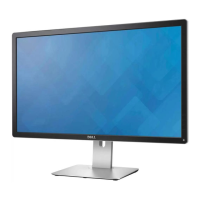
Do you have a question about the Dell P2415Q and is the answer not in the manual?
| Screen Size | 24 inches |
|---|---|
| Resolution | 3840 x 2160 (4K UHD) |
| Panel Type | IPS |
| Aspect Ratio | 16:9 |
| Brightness | 300 cd/m² |
| Contrast Ratio | 1000:1 (typical) |
| Refresh Rate | 60 Hz |
| VESA Mount Compatible | Yes |
| Viewing Angle | 178° horizontal, 178° vertical |
| Color Support | 1.07 billion colors |
| Color Gamut | 99% sRGB |
| VESA Mount | 100 x 100 mm |
| Connectivity | HDMI, DisplayPort, Mini DisplayPort, USB 3.0 |
| Response Time | 8 ms (gray-to-gray normal); 6 ms (gray-to-gray fast) |
Lists the components shipped with the monitor for setup and verification.
Details the technical specifications and capabilities of the P2715Q/P2415Q monitors.
Identifies and describes the front view components and buttons of the monitor.
Details and labels the various ports and features on the back of the monitor.
Identifies and describes the connectors and ports located on the bottom of the monitor.
Provides detailed technical specifications for the flat panel display of both monitor models.
Lists the supported scan ranges and video display capabilities of the monitors.
Details various display modes, including horizontal/vertical frequencies and pixel clock.
Lists the available display modes for Mobile High-Definition Link (MHL) connections.
Describes the types of video signals supported by the monitor's input ports.
Details the synchronization methods supported for video signals.
Specifies the power requirements and current draw of the monitor.
Lists the dimensions and weight of the monitor with and without the stand.
Outlines the operating and non-operating conditions for temperature, humidity, and altitude.
Explains how the monitor enters power save modes based on VESA DPM compliance.
Details the pin configuration for the DisplayPort input connector.
Details the pin configuration for the DisplayPort output connector.
Provides the pin assignment details for the Mini DisplayPort (mDP) connector.
Lists the pin assignments for the HDMI connector.
Details the pin configuration for the Mobile High-Definition Link (MHL) connector.
Describes the USB upstream and downstream ports and their capabilities.
Provides step-by-step instructions for attaching the monitor stand.
Guides users on connecting the monitor to a computer system.
Explains how to connect multiple monitors using DisplayPort MST.
Details the process for connecting and using MHL-enabled devices.
Provides instructions on managing and organizing monitor cables for a tidy setup.
Guides users on how to attach the cable cover for a cleaner look.
Provides instructions on how to safely detach the monitor stand from the display.
Explains the steps to remove the cable cover from the monitor.
Details the process and requirements for mounting the monitor on a wall.
Simple instruction on how to power on the monitor using the power button.
Explains how to use the monitor's front panel buttons for adjustments.
Provides detailed descriptions of each front panel button's function and shortcut keys.
Guides users on how to navigate and interact with the monitor's OSD menu.
Explains how to adjust the screen's brightness and contrast levels via the OSD.
Details how to select the active video input source from the OSD menu.
Covers adjusting color settings and selecting the video input color format (RGB/YPbPr).
Describes the various preset color and image modes available on the monitor.
Explains how to adjust image parameters like Aspect Ratio and Sharpness in the Display menu.
Details how to adjust image aspect ratio and sharpness for optimal viewing.
Covers adjusting dynamic contrast and response time for image enhancement.
Explains screen uniformity settings and DisplayPort MST configurations.
Covers resetting display settings and configuring the power button LED.
Details USB port status and how to reset energy settings.
Covers OSD language, rotation, transparency, and timer settings.
Explains how to lock and unlock the monitor's OSD menu to prevent unauthorized changes.
Details how to reset menu and personalization shortcut key settings to defaults.
Explains Display Data Channel/Command Interface and LCD conditioning features.
Covers resetting specific settings or all OSD settings to factory defaults.
Explains common warning messages displayed by the OSD, such as for brightness or resolution issues.
Explains DDC/CI function disabling and monitor entering power save mode.
Describes messages related to no signal and how to select the correct input source.
Explains messages displayed when input cables are not connected.
Details how to adjust the monitor's tilt and swivel for optimal viewing angles.
Explains how to extend the monitor stand vertically for height adjustment.
Provides instructions on how to physically rotate the monitor for portrait view.
Guides users on configuring system display settings for rotated monitor orientation.
Explains how to use the monitor's self-test feature to diagnose display issues.
Describes the monitor's diagnostic tool to identify screen abnormalities.
Lists common issues encountered with monitors and their potential solutions.
Continues the list of common monitor issues and their corresponding solutions.
Addresses specific issues related to monitor features like screen size and controls.
Troubleshoots issues related to the Mobile High-Definition Link (MHL) interface.
Provides essential safety warnings and precautions for using the monitor.
Contains FCC compliance information and other regulatory details for the monitor.
Offers guidance on how to contact Dell for support and service.
Guides on setting the optimal display resolution of 3840 x 2160 for best performance.
Provides instructions on how to clean the monitor safely and effectively.